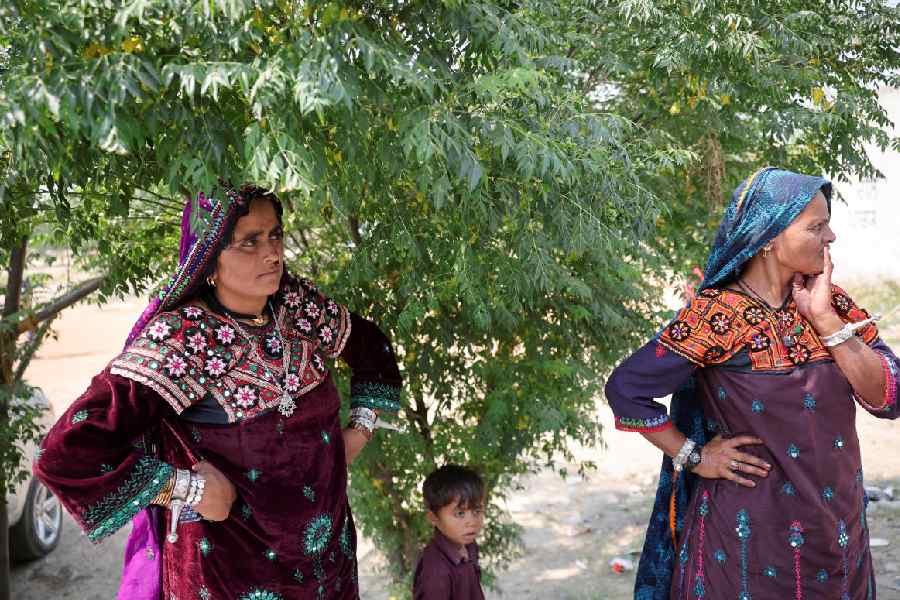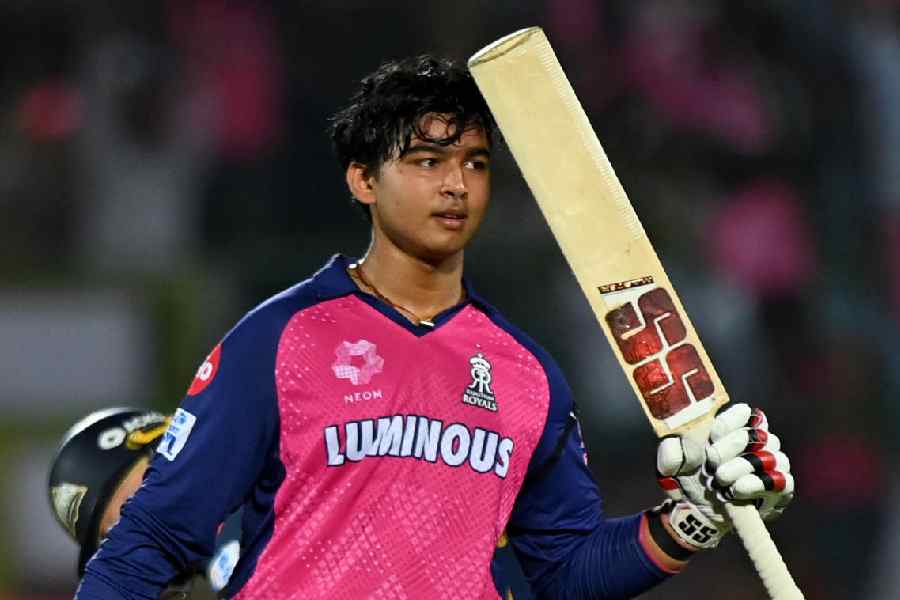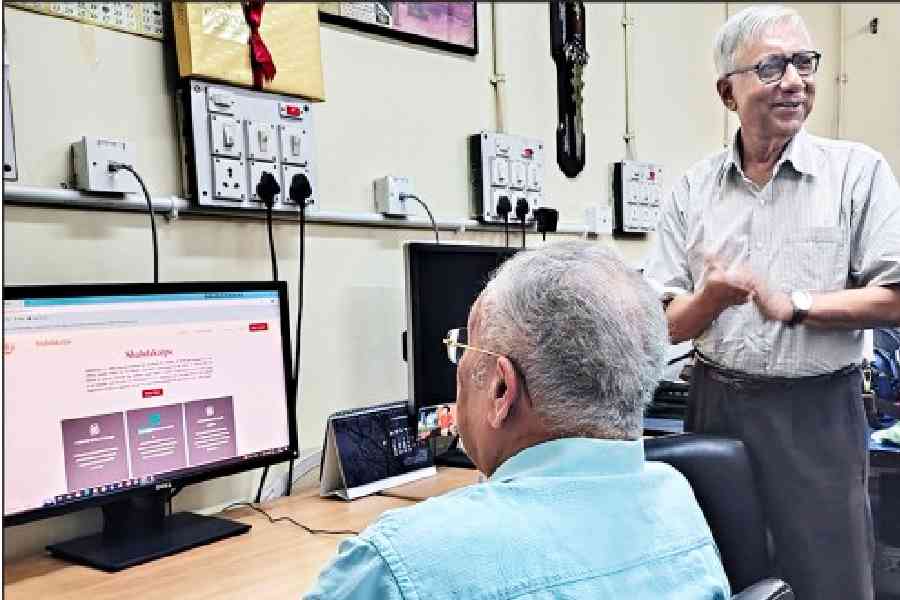
Agartala, Aug. 13: The manicured patches of green in the paved front yard of the white-and-peach building are smudged with brown. Many of the saplings planted to create a lush look had long been uprooted by thieves.
At the Dasharath Deb Sports Complex Gymnasium on the slushy outskirts of Agartala, as with most things to do with Indian sport, ambition has tended to outstrip achievement.
Except with its most famous pupil. Which is why it’s so important that Dipa Karmakar wins a medal tomorrow in Rio.
It was difficult to ignore the sense of bleakness on Tuesday afternoon as this reporter entered the cavernous gym hall with its pale green walls, where a 14-year-old Dipa began training nine years ago.
Perhaps it was the fusty smell that blended with the odour of sweat as the children practised on the blue-and-yellow balancing beams, horizontal bars and pommel horses that looked in need of a coat of paint.
Perhaps it was the dimness — much of the lighting doesn’t work except right above the practice area. Or the dust in the corners — the coaches and trainees themselves have to clean the state-run gym because the sweepers tend to play truant.
Or perhaps it was the almost eerie quiet — surprising for a place where a bunch of schoolchildren were training — apart from the muffled thuds of children landing after a vault or the creaks of the horizontal bar.
Occasionally, the silence was broken by a coach’s sharp command: “Legs tight”, “you aren’t getting it right”, “legs loose”, “toes together”…. Just as well, too, for a slip can extract a terrible cost.
“Not all the trainees are here, you see,” Bijan Das, assistant director of sports who is in charge of the complex, tried to explain the quiet.
One reason they were not all here was that they had no choice. “We don’t get to practise daily; the students of the (Sports Authority of India’s) sports school practise four days a week and we get three,” said Pranab Rakshit, a Class VIII student from the Pranabananda Vidya Mandir.
Asked if this was the way to produce champions, Das said the gym hadn’t enough equipment for all its 70 trainees to practise together.

But why were just about a dozen children present during prime-time training: 3.30-6.30pm (which follows a short morning session between 7.30 and 9)? Absenteeism is high, Das acknowledged.
Pranab’s mother Chhanda, who has accompanied him to the gym, provided a clue: “Studies come first.”
“I love gymnastics but there are my tuition classes to take care of,” said trainee Samarpita Das, daughter of businessman Santi Das and a student of Sri Krishna Mission School.
Perhaps Dipa has a chance to sow the seeds of a change tomorrow.
“Dipa trained all seven days — there were no restrictions for her,” Das said. Dipa had won the national junior championship the same year, 2007, when this complex opened and she shifted to it.
Dipa had begun training, as a five-year-old in 1998, at the Vivekananda Byamagar, set up as a thatched-roof-and-mud-floor private club for bodybuilders and weightlifters in 1947 but transformed into a gymnastics hub in the 1960s.
The transformation was the handiwork of Duleep Singh, a coach who arrived from Haryana in 1964 and helped Tripura to the 1968 junior national championship and Bharat Kishore Debbarma to the individual champion’s medal.
Along came Mantu Debnath, junior and senior national champion for several years, and Kalpana Debnath, national champion and the first woman gymnast to win the Arjuna Award.
When Dipa joined the Byamagar, coach Soma Nandi, now 55, took her under her wings. By late 2000, however, Soma realised that her pupil deserved better facilities and took her to the state-run Netaji Subhas Regional Coaching Centre, where Dipa began training under her current coach, Bishweshwar Nandi.
“I coached her for two years, after which Bishweshwar Nandi took over,” Soma told this newspaper. In 2007, the Dasharath Deb Complex overtook the Netaji Subhas Centre as Agartala’s gymnastics hub.
Of the 70 trainees enrolled with the complex now, some 40 are children of “rickshaw-pullers, masons, day labourers and small shopkeepers”, said coach Banasri Debnath.
Still, they are enthusiastic enough to wade or ride rickshaws through 5km of slush from the heart of Agartala to reach the gym.
“The others come from lower-middle-class families. Gymnastics here is still not a sport for the rich,” Banasri said.
Not all the parents can afford fish or meat, so they are advised to serve their children “three full rice meals a day with masur dal and an egg and, if possible, milk and fruit”, Das said.
Dipa, daughter of a Sports Authority of India weightlifting coach, didn’t have diet issues, Das said. “She also would have a lot of dry fruit.”
Das disputed the legend that Dipa had practised the Produnova on a makeshift springboard made of scooter parts.
“It’s not true. Dipa had on her own picked up the first of the two somersaults that a Produnova involves; for the second she practised at coaching camps in Calcutta and Delhi with a foam or rubber pit placed below to avoid injuries,” he said. “This is normal practice in all gyms across the world, though pits are not allowed in actual competition.”
Dipa has for the past four years been mainly training in Delhi. “But she comes to the gym whenever she is in Agartala and spends time with the other kids and helps them. She is an inspiration; all the trainees look up to her,” Das said.
Appointed a state sports officer last year, Dipa is a trainee as well as a trainer.
The gym admits trainees between the age of 5 and 12 but they are allowed to practise here till they retire from gymnastics. Most leave early, though.
Ashfaqul Zaman, 19, was practising at the Dasharath Deb for the last time on Tuesday. He had come to say goodbye to his coach, Das. “I have been selected for army recruitment and am leaving for Shillong tomorrow,” a downcast Ashfaqul said.
Das shook his head. “This is our problem. At the back of their mind, the children are always thinking of joining the army, paramilitary or police because of their poverty.”
For now, Das has his hopes pinned on Asmita Paul, 14, who made it to the world school gymnastics championships in Turkey last month though she didn’t win a medal.
The gym has its share of horror stories too. A young Ajay Kumar has been confined to a wheelchair since injuring his head and neck while doing double somersaults during a floor exercise in 2012.
In 1997 and 1998, two gymnasts had died of spinal injuries suffered while training at the Netaji Subhas Centre.
“You see, the foam pits and rubber pits are used only for the Produnova vault --- in case of the horizontal bar, say, you don’t know where to place them because you can’t predict which way the gymnast may slip or fall,” Das said.
On Tuesday afternoon, the trainees turned to their apparatuses after the mandatory 20 push-ups and 20 pull-ups, followed by stretching and freehand exercises.
Asma Begum, 12, did a round on the balancing beam, twisting and turning and spending the inevitable time in the air.
“Was it okay, ma’am?” she asked breathlessly. Coach Banasri smiled and nodded.
Some were practising vaults --- 10 each. No Produnovas, though.
“Those the parents will not allow,” Banasri said. “Dipa did it through her own dogged insistence.”










